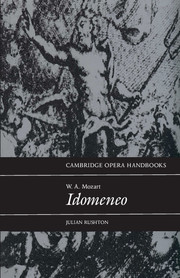Book contents
- Frontmatter
- Contents
- List of illustrations
- General preface
- Acknowledgements
- Introdution
- 1 Synopsis
- 2 Genesis of an operone
- 3 ‘Madame Dorothea Wendling is arcicontentissima’: the performers of Idomeneo
- 4 The genre of Idomeneo
- 5 From myth to libretto
- 6 Idomeneo after Mozart
- 7 General structure of Idomeneo
- 8 Two soliloquies
- 9 The musical language of Idomeneo
- 10 Tonality and motive
- 11 Elettra's first aria and the storm scene
- 12 Conclusions
- Notes
- Select bibliography
- Index
- Plate section
7 - General structure of Idomeneo
Published online by Cambridge University Press: 05 June 2012
- Frontmatter
- Contents
- List of illustrations
- General preface
- Acknowledgements
- Introdution
- 1 Synopsis
- 2 Genesis of an operone
- 3 ‘Madame Dorothea Wendling is arcicontentissima’: the performers of Idomeneo
- 4 The genre of Idomeneo
- 5 From myth to libretto
- 6 Idomeneo after Mozart
- 7 General structure of Idomeneo
- 8 Two soliloquies
- 9 The musical language of Idomeneo
- 10 Tonality and motive
- 11 Elettra's first aria and the storm scene
- 12 Conclusions
- Notes
- Select bibliography
- Index
- Plate section
Summary
The libretto
For all its allegiance to Franco-Italian reform opera, Idomeneo remains within the eighteenth-century norm of alternation of action and introspection, recitative and aria. The three ensembles are more closely merged with the preceding recitative than most of the arias, and all proceed from dialogue to combined voices, yet they function like multi-voiced arias more than the developing ensembles Mozart cultivated in opera buffa; they do not further the action. Three static numbers involve solo and chorus, and the full choruses are largely decorative; only the shipwreck, the end of Act II and - static as it is - No. 24 (‘O voto tremendo’) involve the chorus closely with the principals.
The general structure of the libretto is admirably simple; all three acts begin intimately, and end in public scenes. Act I unfolds the pattern in two stages. A monologue and dialogue are followed by a semi-public scene of rejoicing. The first dramatic event is the announcement of Idomeneo's shipwreck. We are then confronted with the intimate feelings of Elettra, and, after the storm, with those of Idomeneo, before another dialogue. Haltingly, the action returns to soliloquy (Idamante) before the public scene of the divertissement. Such a stop–go process is perhaps a necessary concomitant of exposition. Mozart's cutting axe hardly fell on Act I, which lasts fifty to fifty-five minutes.
The second act, the shortest at around forty-five minutes, begins with an opera seria sequence of dialogues and soliloquies before the public scene focuses on Elettra. After the trio the finale brings the elements, the people, and the king into fierce dispute.
- Type
- Chapter
- Information
- W. A. Mozart: Idomeneo , pp. 95 - 105Publisher: Cambridge University PressPrint publication year: 1993



